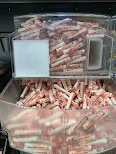As I delve into this insightful exploration of embodied mathematical cognition, several stops along the way have caught my attention. Here are two key moments that resonated with me.
1. Antagonistic Nature of Education: The introductory
passage about living in an antagonistic society and the parallel drawn to
education sets a powerful stage for the paper. The contrast of the real and the
imaginary, the concrete and the abstract, creates a lens through which we view
the challenges in education. The authors highlight the tension between what
teachers are trained to perceive as "normal" and the diversity within
their classrooms. This makes me wonder: how can educators learn to recognize
and appreciate the diverse ways in which students perceive and engage with
mathematical concepts? Indeed, this stop raises awareness about the need for a
shift in perspective within the educational system, urging teachers to adapt
our methods to embrace diverse learning styles.
2. Multimodal Resources and Embodied Learning: The paper's core argument revolves around the embodied perspective on mathematical cognition. The experiences of two blind students navigating symmetrical figures and geometrical transformations become a lens through which we understand the interplay between the body and cognition. One of the pivotal moment is when the discussion transitions from symmetrical figures to reflection. Edson, with visual memories, leverages his past experiences with mirrors to conceptualize and articulate mathematical properties. In contrast, Lucas, without visual memories, relies on tactile exploration and hand movements. This makes me wonder: how do the embodied experiences of individuals shape their approaches to mathematical understanding? Certainly, this stop encourages a deeper exploration of how personal histories and sensory modalities influence cognitive processes.
Questions for Discussion:
- How
can educators cultivate an inclusive learning environment that recognizes
and accommodates diverse embodied experiences in the teaching of
mathematics?
- In what ways might the reliance on sighted learners' trajectories hinder the development of effective learning scenarios for blind students, and how can educators overcome this challenge?
Week 2 activities
Engaging in hands-on
mathematical activities, inspired by the videos and readings, has been a
transformative experience for me. The combination of visual, tactile, and
sensory elements brought the mathematical concepts to life in a way that simply
reading or watching videos could not achieve.
Firstly, experimenting with data analysis using candies allowed me to apply abstract concepts in a concrete and delicious way. Creating a Bar Graph and Pie Chart with Rockets and Smarties not only reinforced my understanding of data representation but also made the learning process enjoyable. It was a reminder that mathematical activities can be both educational and fun, especially when they involve something as universally appealing as candy.
Bar Graphs:
Pie Chart
The exploration of
hexaflexagons, following Vi Hart's instructions, provided a hands-on experience
with geometry that went beyond traditional methods. The tactile sensation of
folding and flipping the hexaflexagon enhanced my spatial awareness and
geometric intuition. Decorating the surfaces added a creative dimension to the
activity, making it a personalized learning experience.
Cutting a bagel into
a mathematically correct breakfast, inspired by George Hart's video, shifted my
perspective on geometry. The tangible experience of creating interlocking rings
with a real-life object like a bagel added a practical dimension to the
abstract concept. This hands-on activity demonstrated the relevance of geometry
in everyday life, making the learning experience more relatable and memorable.
Considering the
reflection questions, the hands-on experimentation with these mathematical
activities made a significant difference in my understanding. It not only
solidified abstract concepts but also made the learning process enjoyable and
memorable. For students, learning from real 3D objects with various sensory
elements could enhance their understanding and retention of mathematical
concepts. The engagement of multiple senses, such as touch, smell, and taste,
can make the learning experience more immersive and appealing. For students
with sensory impairments, hands-on activities become even more crucial.
Utilizing real-life objects with distinct shapes, textures, and sensory
qualities can provide a richer learning experience. For example, exploring
geometric concepts with objects that can be touched, smelled, or even tasted
can compensate for the lack of visual or auditory stimuli. This approach not
only promotes inclusivity but also recognizes the diversity of learning styles
and preferences among students.


























